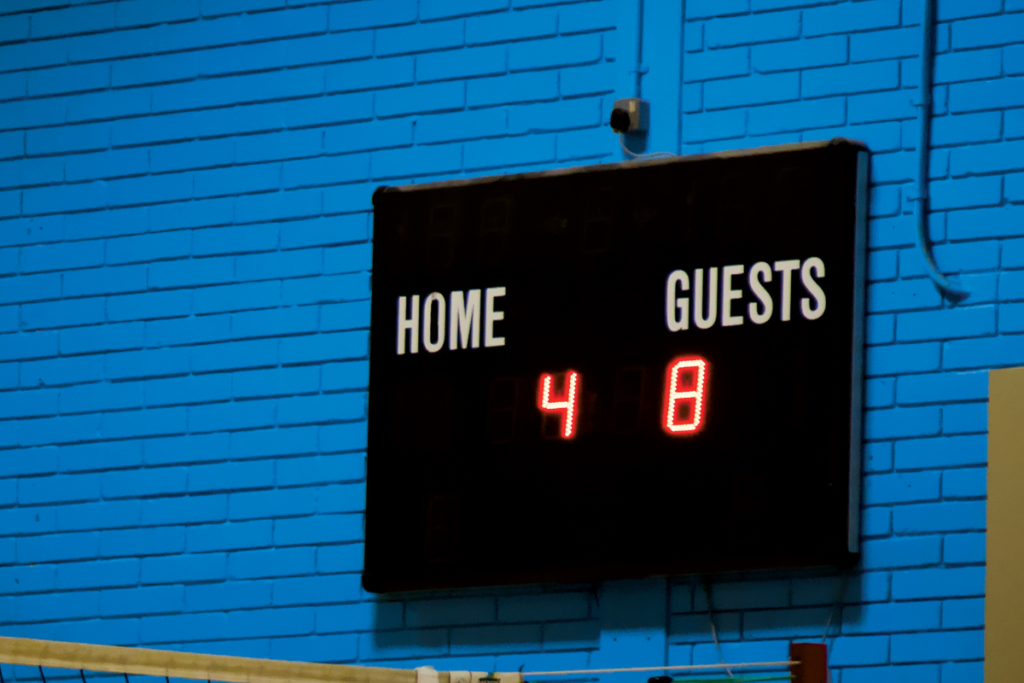Every sport experiences advancements in its gameplay. As we all know, volleyball has also seen certain advancements in its scoring system.
Volleyball Scoring, Additional Rules, and Scenarios
Rally scoring system
Point system – Rally scoring means a point is awarded on every rally, irrespective of whichever team serves. It boosts the game’s pace, as both the serving and receiving teams can earn points.
Win a set – A set is won when a team reaches 25 points and leads at least by 2 points. If the score is a tie of 24-24, the set continues until one team has a lead of 2 points.
Win a match – Generally, matches are played for best-of-5 sets. The team that wins the first 3 sets will win the game. If the match reaches the 5th set i.e., both the teams win 2 sets each. Then a deciding set of 15 points is played which again requires a 2-point lead to win by any team.

Scoring points in Rally scoring
Winning a Rally – The winning team earns a point through:
Spike: A player spikes the ball into the opponent’s court and lands without being returned.
Effective blocking: A team successfully blocks an opponent’s attack, defending the ball to drop onto the opponent’s side.
Opponent errors: If the opponent team makes an error like,
- Hitting out of bounds – Landing the ball outside the court’s boundary lines.
- Net faults – A player touches the net during gameplay.
- Four hits – A team holds the ball on their side for more than 3 touches without returning it to the opponent’s side.
- Double contact – The same player touching the ball twice in a row while playing.
- Foot fault on serve – The serve crosses the service line before hitting the ball.
Service Ace: When a serve is directly considered as a point without the receiving team successfully returning it. The scenarios are:
- The ball lands untouched in the opponent’s court.
- The receiver team touches the ball but cannot control it, and it goes out of bounds.
Side-out scoring system
It is also known as a traditional scoring system. As per the older side-out system, only the serving team could score a point. If the receiving team won a rally they didn’t earn a point but would gain the right to serve. It is known as side-out.
After gaining the serve, the team would need to win another rally to score a point. This scoring system made the games longer, as the teams could only score when they served.
Matches played with side-out scoring require teams to reach 15 points to win a set, with a 2-point lead.
Note – Rally scoring replaced side-out scoring in most competitions by the early 2000s making faster-paced games.
Scoring statistics in competitive volleyball
Kills: A kill is an attack that obtains an immediate point. The reasons are either the ball lands on the opponent’s court without a touch, moved out of bounds by an opponent, or the opponent cannot return it.
Rules of kill —The attack must be planned to score, so it doesn’t count if it’s a free ball or a defensive hit. If the attack leads directly to a point due to an opponent’s error like a blocking error or a misdig. It still counts as a kill.
Errors: It is recorded when a player makes a mistake that leads to a point for the opponent team. It can happen while serving, attacking, blocking, passing, or setting. For example:-
- Service error – Faulty serves like hitting the net or landing outside the opponent’s court.
- Attack error – Hitting the ball out of bounds, into the net, or a faulty back-row attack.
- Reception error – When a player fails to receive the serve, leading to an immediate point for the serving team.
- Set error – An incorrect set, like a double touch or lift, results in a point for the opponent’s team.
- Rotation error – When players are out of their designated rotation order when serving. If it is identified, the team loses a point and the serve too.
Assists: A player who sets the ball, leading directly to a kill by another player, is an assist.
Rules for assists — It only counts as an assist if the set results in a kill immediately afterward.
Block: A defensive stop at the net, where a player stops or redirects an opponent’s attack, leading directly to a point. For example:-
- Solo Block – A single player successfully blocks an attack, resulting in a point.
- Block Assist – Two or more players block an attack, scoring a point. Each player who ever is involved receives a block assist.
Rules for blocks — A block is only counted if it directly leads to a point or results in the opponent’s inability to pass or control the ball.
Digs: A dig is a strategy where a player prevents an opponent’s attack from hitting their court by making a perfect pass or keeping the ball in play.
Rules for Dig—Digs are only considered if they are a defensive action against an attack. They are not counted against a serve or a free ball. A dig will not be counted if the player deflects the ball without control.
Calculation of points
Points scored are calculated for an individual player’s offensive and defensive based on their contribution to scoring, including kills, blocks, and service aces.
Rules affecting scoring
Rotations: When a team wins the serve back after a side-out, players rotate one position clockwise. This rotation ensures that each player serves and plays in both front- and back-row positions.
- Front Row and Back Row players: Only front row players can spike or block the ball near the net. Back-row players must jump from behind the attack line which is about 10 feet, or 3-meter line when attempting to spike.
- Libero: The libero is a defensive specialist who does not have permission to attack or serve. In most leagues, Libero can be replaced by any back-row player without counting it as a substitution. The main role of the libero is to help improve team defense and specialists in receiving serves.
- Timeouts: Teams can call two times per set, which helps in regrouping, strategizing, and breaking the opponent’s momentum. It lasts for 30 seconds.
Let serves: A let serve occurs when the ball touches the net but lands in the opponent’s court. The Umpire uses the sign “let” or net” to signal that a let serve has occurred and the play has been stopped immediately. The ball was returned to the server, who was allowed another attempt.
Note: Later on, removing “let” calls serves to simplify the game.
Understanding volleyball scoring is key to enjoying and playing the game effectively. The rally scoring system ensures every rally counts, making the game fast-paced. Points are earned in many ways—through attacks, blocks, serve, or even from errors made by the opposing team. The scoring system ensures fairness as both teams have equal opportunities to earn points irrespective of who serves.

